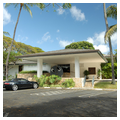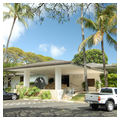A gracious social setting, in many ways more a covered open space than a solid building, the Pacific Club answers the question of what is an appropriate regional architecture for Hawaii. Sited in urban Honolulu on a one-acre lot with a variety of mature trees, the club's primary public spaces seamlessly intermingle with the outdoors while providing a sense of shelter. The white masonry walls assert an exterior sense of solidity and spatial definition, yet the interior spaces merge with a multitude of folding windows and doors and adjoining courtyards. Guests easily transition from the parking lot's shady setting through the inviting porte-cochere and up the stairs to the entrance lounge with its D. Howard Hitchcock mural of Waimea Canyon. The lounge flows into a lanai area open to courtyards on two sides. Around a corner awaits the dining room with its open, wraparound lanai, which on the far side overlooks a terraced pool area and the landscaped grounds.
The Pacific Club is the oldest private club west of the Rockies, having been founded in 1851 by thirteen young British men for the purpose of “promoting friendship and the mutual exchange of opinions among its members, and for providing a place for the reception of strangers, travelers, and residents of the kingdom.” Mark Twain, Robert Louis Stevenson, and Prince Alfred, the first member of a European royal family to visit Hawaii, numbered among the early guests of the club, and Archibald Scott Cleghorn, the father of Princess Kaiulani, was its president from 1865 until his death in 1910. Known as the British Club for much of the nineteenth century, it assumed its current name in 1892, as many members no longer hailed from Britain. It was not until 1968 that this exclusive men's club admitted Asian members, and it took another sixteen years before the first woman was elected to membership.
Vladimir Ossipoff (1907–1998) was the design architect for this project, with Ken Roehrig writing the specifications and Harry Seckel's office handling the drawings. Thompson and Thompson provided the landscape design. Ossipoff was born in Russia, raised in Japan, and moved to Berkeley, California, in 1923. He graduated from the University of California at Berkeley's department of architecture in 1931, and shortly thereafter moved to Hawaii. During the 1950s and 1960s, he established himself as the premier architect in the Islands by blending modern and regional sensibilities in high-quality designs. Other works include the Outrigger Canoe Club (OA152), Bachman Hall at the University of Hawaii (OA122.4), McInerney Store in Waikiki (1957; demolished), and the Robert Shipman Thurston Jr. Memorial Chapel on the campus of Punahou School (OA116.6), as well as numerous residences.


















